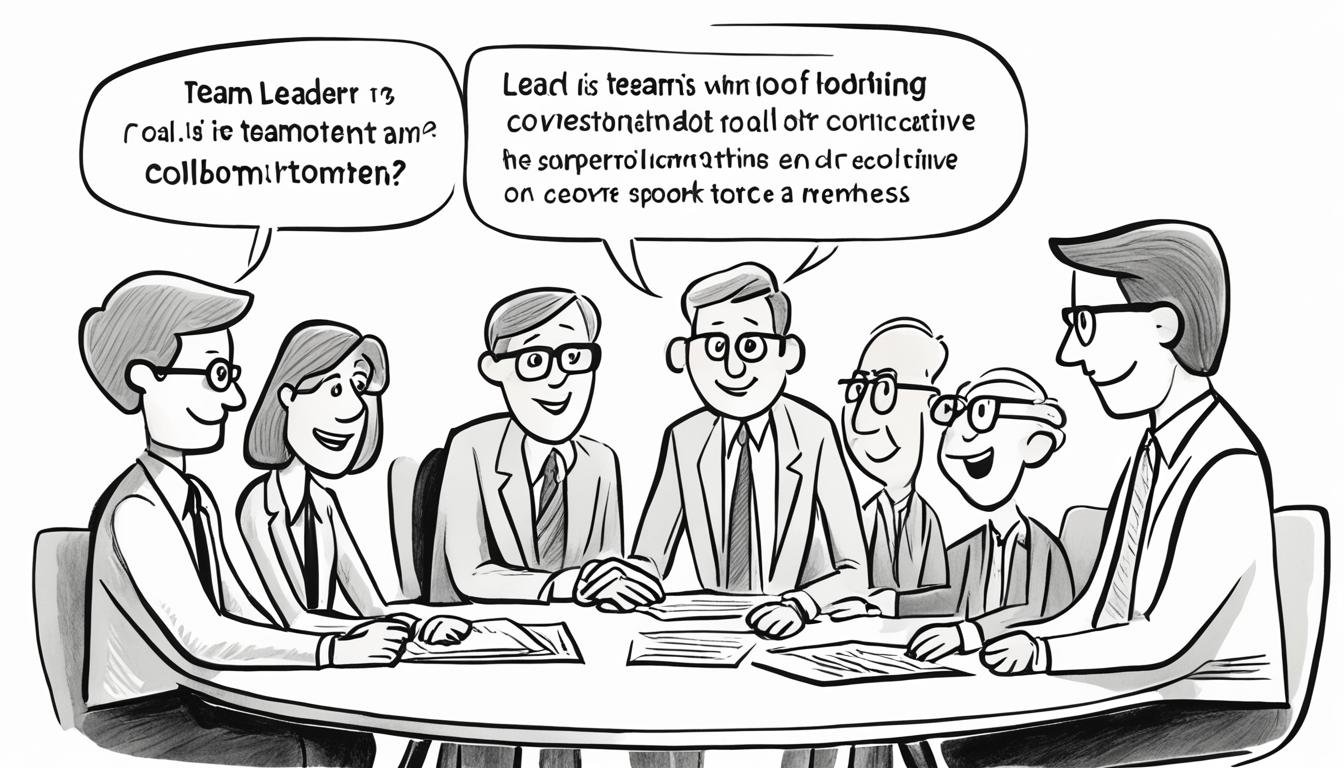Relationship-Oriented Leadership: Prioritizing Team Cohesion and Support
“A true leader has the confidence to stand alone, the courage to make tough decisions, and the compassion to listen to the needs of others. He does not set out to be a leader, but becomes one by the equality of his actions and the integrity of his intent.”
–Douglas MacArthur
Leadership today is changing fast. It’s not just about hitting goals anymore. Real leaders focus on their team’s needs. They build strong relationships and help team members grow. This makes everyone work better together.
Leaders who care about their team use good communication. They build trust and show they understand others. They also make sure their team is happy and involved.
Key Takeaways
- Relationship-oriented leadership prioritizes team cohesion and support.
- Effective communication, trust building, and empathy are key elements of relationship-oriented leadership.
- Relationship-oriented leaders focus on supporting, motivating, and developing their team members.
- This leadership style fosters strong relationships and enhances employee engagement.
- Relationship-oriented leadership creates a positive and productive work environment.
Understanding Task-Oriented Leadership
In our quick-working world, leaders must use various styles to lead their teams well. Task-oriented leadership is one of these styles. It’s all about focusing on the tasks needed to reach specific goals.
Leaders who are task-oriented care a lot about getting things done right and on time. They aim to keep performance levels high. This approach is known for its sharp focus on achieving goals and maintaining performance.
They’re great at breaking tasks down and giving them to team members to handle. They worry less about making everyone happy and more about reaching goals. By doing this, they make sure work is finished when it should be and done well.
But, this style might mean they don’t always consider how their team feels. Always talking about work and rules can make people feel like they’re not valued. Leaders have to remember to mix in some care for their team’s feelings, not just the work.
“Task-oriented leaders are driven by the desire to maintain high levels of performance and ensure that tasks are completed efficiently.”
Key Components of Task-Oriented Leadership
Being a task-oriented leader means focusing on a few key things:
- Performance Maintenance: These leaders work hard to keep their team’s performance top-notch. They set up ways to make sure everyone does their best work efficiently.
- Goal Achievement: They’re all about hitting the goals that were set. These leaders make it crystal clear what’s wanted and how they will get there.
- Productivity: They like to see their team working as well as they can. They look for how to make the work process smoother and better.
- Workplace Procedures: Following the rules and ways of the workplace is key for these leaders. They check that everyone is on the same page to keep quality high.
Benefits and Limitations of Task-Oriented Leadership
| Benefits | Limitations |
|---|---|
|
|
In the end, task-oriented leaders do well where getting things done quickly and correctly is key. But it’s equally important to be mindful of how the team is doing. Creating a happy work environment is crucial for success.
The Benefits of Relationship-Oriented Leadership
Relationship-focused leaders bring many good things to their teams and the organizations they work for. They put people first, helping them and cheering them on. This kind of leader builds strong connections and makes sure everyone talks openly.
Such leaders help each team member get what they need to really shine. They focus on cheering others on, so their team grows and gets better. They push for training and mentorship to help their team members do well in their careers.
They know that good relationships make a strong team. By building trust and encouraging open talks, team members are eager to share and work together. This makes all the difference in reaching the team’s goals.
“Relationship-oriented leadership empowers individuals and creates a culture of trust and collaboration within the team. It promotes a positive work environment where everyone feels supported and valued.”
This way of leading helps team members a lot, but it also makes the whole team do better. When leaders care about their team’s growth and happiness, the team works even harder. This leads to more of the good stuff: happier work, better quality, and stronger team spirit.
And the great thing is, this approach doesn’t just help one team. Companies that focus on building strong, happy teams become places where everyone wants to work. Leaders who build trust and care for their teams see less quitting and more success in the long run.
Comparison of Task-Oriented and Relationship-Oriented Leadership
| Aspects | Task-Oriented Leadership | Relationship-Oriented Leadership |
|---|---|---|
| Focus | Task completion and goal achievement | Supporting, motivating, and developing individuals |
| Team Impact | High productivity and efficiency | Positive relationships and engagement |
Both task-focused and relationship-focused leadership have their strengths. The best leaders know when to use each. They keep the work moving and make sure everyone is supported. This helps the team grow and succeed together.
Task-Oriented vs. Relationship-Oriented Leadership
There are two common leadership styles: task-oriented and relationship-oriented. Each has a different focus and brings unique results. They both have pros and cons for leaders to consider.
Task-Oriented Leadership: This style is all about completing tasks and reaching goals. Leaders using this style care a lot about efficiency, productivity, and following rules. They are all for finishing work on time and keeping performance high. Task-oriented leaders are great at assigning tasks, making sure everyone knows what to do, and staying on target. They love fast-paced settings that need quick decisions and solving problems. Their main aim is to be efficient and achieve the best results.
Relationship-Oriented Leadership: These leaders put building and growing relationships in their teams first. They focus on teamwork, making the work environment positive, and connecting with others. Open talk, seeing things from another’s view, and personal growth are really important to them. They are amazing at supporting and inspiring their team, encouraging unity, and building trust. Their team’s happiness and job satisfaction matter a lot to them. They create a space that helps everyone grow and learn.
Both task and relationship-focused leaders have good points and can do well at different times. Often, a blend of both is the best way to make a team really work well and reach its goals.
Task-focused leadership often means more work gets done and goals are met. But relationship-focused leadership helps the team work better together and learn from each other. The table below shows what each style is really good at:
| Task-Oriented Leadership | Relationship-Oriented Leadership |
|---|---|
| Focus on Tasks | Focus on Relationships |
| High productivity and goal achievement | Greater team cohesion and collaboration |
| Efficient decision-making and problem-solving | Positive work environment and team motivation |
| Adherence to workplace procedures | Trust-building and empathetic leadership |
Understanding what each style is good at helps leaders choose the best one for their team’s needs and the situation. Both task-driven and people-focused leadership can work together really well. They help make the team stronger, more effective, and open to learning.
Advantages of Task-Oriented Leadership
Task-oriented leaders help teams and organizations succeed and be more efficient. They focus on getting tasks done and solving problems. This approach drives productivity and helps meet goals. They make sure everyone knows what’s expected and has what they need. This way, teams work better and faster.
Being efficient is a main benefit of task-oriented leadership. These leaders are good at organizing work, making things simpler, and spotting where work might get stuck. They are great at solving problems, so they get past roadblocks and come up with new ways to work better. They are also skilled at sharing out work, making sure resources are used well, and keeping to deadlines.
Task-oriented leaders help create a culture where the focus is on reaching goals. They motivate team members to do their best and take responsibility for what they do. This helps keep performance high.
“Task-oriented leadership drives efficiency, productivity, and goal achievement by setting clear expectations, providing necessary support, and prioritizing task completion.” – First source
This leadership style is perfect for teams or organizations that need to work in an orderly way. It makes sure work is done well and on time to avoid mistakes. It also helps everyone be disciplined and take ownership of their work.
In summary, task-oriented leadership is key for teams and organizations. It helps them be more efficient, solve problems, and reach their goals. By focusing on getting things done and meeting targets, these leaders help teams perform at their best.
| Advantages of Task-Oriented Leadership |
|---|
| Focus on results and goal achievement |
| Efficiency in completing tasks |
| Strong problem-solving skills |
| Clear expectations and task prioritization |
Disadvantages of Task-Oriented Leadership
Task-oriented leadership boosts productivity and helps reach goals. But it also comes with downfalls. These can affect how a team works together and their overall success.
Micromanagement
Micromanagement is a big issue with this style of leadership. Leaders might watch team members too closely. This can lower trust and make people feel they have no freedom. When a leader micromanages, it often stops the team from being creative. It can also make everyone feel less motivated. In the end, the team might not work as well as it could.
Lack of Flexibility
Task-oriented leaders love to follow a plan and finish tasks well. This helps the team work by the rules. But, it can also cause problems when things need to change fast. In situations where the world changes quickly or decisions must be made on the spot, being too focused on tasks can be a downside. It might stop the team from handling new, unexpected issues well.
Limited Creativity
This style of leadership prefers meeting goals over being creative. By only looking at finishing tasks, it can stop new ideas from coming. This might keep the team from finding better ways to solve problems. Without creativity, a team might struggle to face new challenges.
Leaders need to find a middle ground between caring about tasks and caring about their team. By knowing the downsides of task-oriented styles and working to fix them, leaders can help their team work better. They can make an environment where working together and being creative are the norm. At the same time, they ensure the team keeps its eyes on achieving their goals.
Advantages of Relationship-Oriented Leadership
Relationship-oriented leadership helps teams succeed and stay together. Leaders focus on strong team bonds and trust. They create a work environment that’s positive and makes team members want to do their best. This style brings the team together by caring for each person’s well-being.
Creating Strong Relationships: Building trust and strong bonds comes first for these leaders. They spend time getting to know each team member. This makes communication and working together better.
Enhancing Motivation: Keeping the team motivated is key. These leaders figure out what drives each person. They offer personalized support and praise. This makes team members want to do well in their jobs.
Fostering Team Unity: Good relationships and clear communication bind the team. Leaders create a space for discussion, cooperation, and solving problems together. This ensures everyone is working towards a common goal smoothly.
“A good leader takes a little more than his share of the blame, a little less than his share of the credit.” – Arnold H. Glasow
Strengthening relationships, boosting team morale, and encouraging unity have big benefits. When they know they are valued and supported, team members often do more than just their tasks. They aim for the team’s overall success.
Example Table: Comparing Relationship-Oriented and Task-Oriented Leadership
| Aspects | Relationship-Oriented Leadership | Task-Oriented Leadership |
|---|---|---|
| Focus | Building strong relationships, trust, and team cohesion. | Task completion, goal achievement, and efficiency. |
| Advantages |
|
|
| Disadvantages |
|
|
Table: Comparing Relationship-Oriented and Task-Oriented Leadership
Disadvantages of Relationship-Oriented Leadership
Relating well with team members can lead to stronger bonds and support. Yet, focusing on relationships can have downsides. We’ll look at some challenges leaders face with this style.
Difficulty Making Tough Decisions
Choosing the hard paths can be tough for relationship-oriented leaders. They might avoid making decisions that risk their bonds. Wanting to keep peace can slow down important decision-making, especially for issues the team faces.
Less Effective in Fast-Paced Environments
In quick-moving settings, this approach might not work as well. Leaders could find it hard to keep pace. Their focus on relationships might not match the needs of a fast-changing work scene. This could lead to the team struggling to keep up.
Tolerance of Poor Performance
They might let poor work slide to maintain good relationships. Addressing performance issues can be hard for these leaders. Some may avoid giving hard feedback or setting clear standards. Tolerating bad performance can hurt the team’s results.
| Disadvantages of Relationship-Oriented Leadership |
|---|
| Difficulty Making Tough Decisions |
| Less Effective in Fast-Paced Environments |
| Tolerance of Poor Performance |
Finding a balance is key for leaders. While building good connections is vital, so is effective decision-making and managing performance well. Acknowledging these downsides is crucial for a leader’s lasting success.
Situations Where Task-Oriented Leadership is Effective
Task-oriented leaders shine in situations needing fast decisions and clear goals. They are great at managing tasks efficiently. This makes them key players in fast, high-pressure settings.
They quickly get to the core of time-sensitive issues and complex problems. Their knack for setting clear tasks and using resources wisely boosts productivity. Team members know just what’s expected of them, creating focused workspaces. This drives everyone toward common goals.
In team conflicts, these leaders step up. They fix issues with care and speed, which opens pathways for better teamwork. Their clear, objective actions promote open discussions. This leads to a work atmosphere where everyone gets along.
“Task-oriented leadership is highly effective at driving results, ensuring accountability, and managing complex projects within tight timelines. Leaders who prioritize efficiency, quick decision making, and conflict resolution are vital assets to organizations.”
In any situation demanding time management and clear directions, task-oriented leaders stand out. They combine quick decision-making, clear goals, and conflict solving to lead their teams to success. This approach works wonders in challenging environments.
Examples of Situations Where Task-Oriented Leadership is Effective:
- Managing a critical business project with strict deadlines and specific deliverables
- Handling a crisis or emergency situation that requires swift decision making
- Implementing new processes or systems that require adherence to established procedures
- Resolving conflicts and addressing performance issues within a team
- Coordinating tasks and delegating responsibilities to ensure efficient workflow
| Situation | Task-Oriented Leadership Approach |
|---|---|
| Managing a critical business project with strict deadlines and specific deliverables | Task-oriented leaders excel at creating project plans, setting clear goals, and monitoring progress to ensure timely completion of tasks. |
| Handling a crisis or emergency situation that requires swift decision making | Task-oriented leaders quickly assess the situation, gather relevant information, and make decisive choices to address the crisis effectively. |
| Implementing new processes or systems that require adherence to established procedures | Task-oriented leaders focus on ensuring team members understand and follow established procedures to ensure smooth implementation and minimize disruptions. |
| Resolving conflicts and addressing performance issues within a team | Task-oriented leaders approach conflicts objectively, mediate discussions, and establish clear expectations to address performance issues and restore harmony within the team. |
| Coordinating tasks and delegating responsibilities to ensure efficient workflow | Task-oriented leaders distribute responsibilities based on individual capabilities, establish deadlines, and closely monitor progress to maintain an efficient workflow. |
Task-oriented leadership is all about making quick, smart choices and ensuring everyone knows their part. But remember, mixing this style with a focus on relationships also benefits the team. A leader who values both approaches can achieve greatness.
Situations Where Relationship-Oriented Leadership is Effective
Relationship-oriented leadership works well when a team needs a morale boost. It’s also good for solving conflicts or uniting a team for new challenges.
Leaders of this type focus on making a happy workplace. They do this by building strong bonds, trust, and encouraging everyone to work together. This makes the team happier and more satisfied with their jobs.
If there’s a conflict, these leaders are good at fixing it. They talk and listen to sort things out fairly. This keeps the work environment peaceful and productive.
When there’s a new project, these leaders ensure everyone is on the same page. They motivate the team to aim for a shared goal. This creates a spirit of working together and being fully committed to the task at hand.
| Benefits of Relationship-Oriented Leadership in Situations: | |
|---|---|
| Improved team morale | Team Morale |
| Effective conflict resolution | Conflict Resolution |
| Enhanced team unity and cohesion | New Projects or Challenges |

These leaders strive to make an environment that’s welcoming to everyone. They ensure people feel valued and ready to work hard. This leads to better team work, stronger friendships, and an overall boost in how well the team does.
Conclusion
There are two key leadership styles: relationship-oriented and task-oriented. Both are important for a team’s success. Relationship-oriented leaders work to make the team close-knit. They focus on building strong bonds and keeping everyone happy. This approach helps team members feel valued and supported. It boosts their morale and improves the team’s overall performance.
Conversely, task-oriented leaders put more emphasis on getting things done. They make sure the team knows what to do, provides the necessary tools, and meets deadlines. Task-oriented leaders are great at organizing and keeping the group productive.
Effective leaders know the value of blending these two styles. By using both relationship and task-focused approaches, they can make a supportive work atmosphere. This leads to a team that works well together, supports individual growth, and meets its goals.
In the end, successful leadership is about meeting team and organizational needs. By combining these two key styles, leaders create a space where teamwork thrives. A workplace where team members are happy and success is achieved. It takes a leader who supports and guides to help both the team and the organization succeed.
FAQ
What is relationship-oriented leadership?
Relationship-oriented leadership is all about supporting and motivating people. Leaders focus on developing strong connections within their team. They stress the importance of trust, good communication, and leading with empathy.
What is task-oriented leadership?
Task-oriented leadership aims at hitting certain goals by focusing on the tasks at hand. It’s about getting the job done efficiently, often through procedures and standards.
What are the benefits of relationship-oriented leadership?
This approach makes team members feel supported, valued, and understood. It leads to higher job satisfaction and better teamwork. Members are more engaged and work better together, boosting the overall performance.
How do task-oriented and relationship-oriented leadership differ?
Task-oriented leadership is all about meeting goals. It can lead to more productivity but not necessarily better team cohesion. On the other hand, relationship-oriented leadership focuses on forming strong bonds within the team.
This style helps in learning as a group. But, a mix of both usually works best for success.
What are the advantages of task-oriented leadership?
Task-oriented leadership is great for getting results. It makes sure tasks are done efficiently and that everyone knows what is expected of them. This not only boosts productivity but also makes things run smoother.
What are the disadvantages of task-oriented leadership?
However, it can lead to micromanaging and stifle creativity. It might make employees feel their ideas aren’t valued, which can lower morale.
What are the advantages of relationship-oriented leadership?
This approach builds trust and unity within teams. It makes the work environment positive and supports individual well-being. It increases team members’ happiness, engagement, and promotes working well together.
What are the disadvantages of relationship-oriented leadership?
But, it might be hard to make tough calls that affect relationships. In very fast-paced settings, it could also be less efficient. Sometimes, it could lead to accepting low performance to keep relationships good.
In what situations is task-oriented leadership effective?
Task-oriented leadership shines when quick, decisive actions are needed. It’s perfect for ensuring tasks are done right and on time. This makes it ideal for project management or hitting deadlines.
In what situations is relationship-oriented leadership effective?
It’s great for turning around low morale or solving conflicts. It’s also key for challenges that demand strong teamwork and unity. This style excels at building trust, encouraging cooperation, and creating a supportive climate.
How do task-oriented and relationship-oriented leadership styles differ?
One focuses on goals, the other on team relationships. A blend of both works best, tailoring leadership to the task at hand. A balanced leader ensures their team is efficient and works well together.








